The Jaguars and Wildlife of Brazil’s Pantanal
Trip Report 2011
The Jaguars and Wildlife of Brazil’s Pantanal
Trip Report 2011
.jpg)


This Jaguar Photo Safari marks our fourth to the Pantanal, beginning four years ago when two friends and I did a scouting trip and found all the claims of great jaguar shooting to be accurate. We based ourselves at two locations, one a land-based lodge where we spent the first night and our last two nights, and five nights on a houseboat in the heart of jaguar country.
We had 8 good Jaguar sightings, representing 5 different jaguars, and some excellent Giant Otter sightings and photography. On two occasions the sightings and shooting was extensive: Mary had a pair of Jaguar brothers for near 1.5 hours, almost a full hour before the rest of the group reached her. These Jaguars were hunting, disappearing for short times before reappearing on the river edge again. On the last day of the trip we had a Jaguar at our land-based lodge, and this female proved to be one of the most cooperative and exciting cats we’re ever filmed. We had her for hours, ending our observations after watching her hunt for caimens and fish and swimming across a river where, as the light continued to fail, we left her to continue her hunts. Over the years the Giant Otters have become increasingly accessible -- our first two years we were happy to even get a chance at a halfway decent shot, and now we’re doing headshots and all types of close-up behaviors. The shooting has only gotten better.
Make the most of any Photo Tour or Safari. Take our Digital Complete Nature Photo Course
and learn the essentials of photography, especially manual exposure
with spot-metering,
flash, digital workflow and RAW conversion. Seriously!
Also offered in 2012 in southern Arizona.
The following is the day by day journal of the trip, detailing these observations and more.
 Day 1, August 25.
Day 1, August 25.
With less than three days home after three weeks in coastal Alaska we were back in Brazil, and as I write this we’re bouncing down the macadam road that leads, 100km later, to the TransPantanal Highway. Our flight down was uneventful, although in Sao Paulo part of our group would have missed the flight to Cuiaba except our flight was cancelled, and all of us ended up on the same flight down. Our guide met us, our luggage all arrived, and we were off.
Flying in to Cuiaba, the capital city of the state of Matto Grosso, we passed over a surprising amount of farm country, with dry, brown rectangles partitioning the land in all directions. Brazil, home of the heartland of the Amazon, surprises many American tourists with its settlements and development and cities, this misconception all the more at odds with the reality as Brazil continues its progression as a major developing world powerhouse. At this point in time Brazil ranks third in the prosperity of developing countries, with a booming economy. The city, and its suburbs, numbers over 1 million, an astonishing number when one thinks of this as the gateway city to the Pantanal.
We crossed the cerrado, a dry, savannah upland that is home to hard-to-see oddities like the Giant Anteater and Maned Wolf, and as we neared the city of Cuiaba the sinuous, snaky Cuiaba River came into view, stretching through the dusty haze to the horizon. The landscape here is flat, and the river, unencumbered by any topography of note, created sharp oxbow bends as trees or shoreline weaknesses funneled the water in its slow, meandering direction. We’ll meet the Cuiaba River again in two days, at Porto Joffre, where we’ll board our boats to head upriver to the heart of Jaguar country. From the air, it was heartening to see sufficient riverine vegetation to serve as a wildlife corridor, where jaguars might still migrate along the waterway.
Our 60km bus ride down the Transpantanal Highway was fun and rewarding, and Mary and I felt an excitement and sense of elation at being back. Shortly after entering the Pantanal, and after our first stop, exactly at the park boundary and welcoming sign, where we observed our first mud-slicked, shiney Capybaras, we spotted a pair of Red-legged Seremias, the South American equivalent of the African Secretarybird. We were excited, never having seen this bird of the grasslands in the Pantanal, and we considered this a great omen. The long-legged Seremias are built almost identically to their African counterpart, differing only in color – these are a flat gray, and in the feathery crest that extends above their crown. In secretarybirds this is replaced by some long, plume-like feathers.
We continued, under a lowering sun when our driver screeched to a stop and our guide exclaimed, ‘Giant Anteater!’ The driver backed up and I thought I saw the anteater hiding in the brush but my search image, the mind’s eye vision one has that so often helps in spotting well-camouflaged animals, was too finely tuned and the animal turned into a pile of brush. We exited the bus and our guide and I scoured the thickly vegetated, brushy field while the rest of the gang walked an elevated roadway hoping to spot the animal. We missed it, but again, as an omen, it was a wonderful start.
Roseate Spoonbills glowing a dull pink in the setting sun, foraging Coatimundis, a beautiful Jabiru Stork with two chicks in a pink flowered, Ype’ Tree, and most of the good Pantanal birds, plus piles of caimens and too many frogs or toads hopping across our path, it was a great start and a wonderful drive.
We arrived at our lodge shortly before 7PM, checked into rooms, and assembled for a dinner and orientation. Afterwards, I walked the grounds with a powerful flashlight, spotting toads, several huge treefrogs, and a very wary little Rana-like frog that skittered across the leaf-litter low and fast, before burrowing beneath some fallen leaves where it hunkered down, immobile. Had I not see it stop I’d have missed it, this frog that most resembled a Florida Gopher Frog.
By the light of my torch I watched over a dozen Capybaras appear on the opposite river bank, and scores of firey, orange-glowing eyes of caimens lining both shores of the river. A Whistling Heron flew high to a perch, producing a call quite unexpected for a Heron, and giving validity to its name.

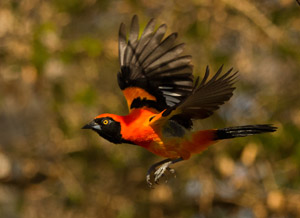
Day 2. Our first full day in the Pantanal, and my birthday, and we slept in, not because of any sense of celebration but trying to still catch up on an exhausting couple of days, flying from Alaska, working late in the office, and flying to Brazil. By 7 we were out, but the sun had been up an hour with most of our participants out and about, at the Jabiru Stork nest, where a spiral staircase lead to an observation deck within 70-200mm range of an active nest with three nearly full-grown chicks, or at the various bird feeders.
I made the rounds, checking on everyone, and they were happy with the shooting. Birds were everywhere. After breakfast, most of us spent time at the feeder right outside our room where a trio of Orange-backed Troupials, electric orange orioles, flew repeatedly to a hummingbird feeder. Several Tanagers, including Silver-billed, Sayaca, and a new one, an Epaulet Oriole, also visited the tree. The grounds were noisy with the calls of Monk Parakeets that nested in huge stick nests at the top of several of the trees, and Chachalacas, big, brown, pheasant-like birds, called loudly from their perches in the surrounding trees.
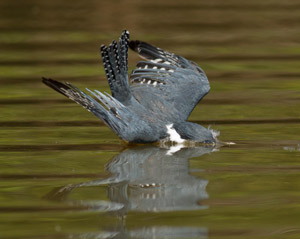

At 9 we headed down river attempting to photograph Greater Black Hawks, Black-collared Hawks, and Ringed Kingfishers that respond to fish. I missed our only opportunity at the Black Hawk when the 400mm I was using didn’t focus – I had the lens on MF rather than auto! We had two fair to good passes with the Black-collared Hawk, with one bird flying in perfectly and then deciding not to snag the fish but to perch instead. When it did go for the fish it faced away from us, giving my boat a back end view.
Still, the morning was a great one, with flying White-necked Herons, Neotropical Cormorants, Anhingas, and huge Ringed Kingfishers. It was hot but not oppressive, but by noon, when we returned, the air did feel like an open oven when we stepped out from an air conditioned room.
At 3:30PM we did another boat trip, this time downriver to look for one of the rarest and most beautiful of the herons, the Agami Heron. Mary’s boat spotted two, and although we motored up to the one sighting the directions were too ambiguous and we missed it. Later, her boat took a big risk and plowed through the thick, river-choking water hyacinths to reach our old spot for this heron, and they were rewarded with one perched completely in the open. It was late, and dark, but with flash at least a few people probably managed to get some shots.
.jpg)
Mary's Agami Heron - a real trophy.
Bird and Caimen shooting was good. We found six baby Spectacled Caimens that were so confident of their cryptic .jpg) camouflage that not one moved as we floated to within five feet of the banded black babies. A pair of Sunbitterns performed wonderfully, with one bird teasing us by out-stretching a wing, partially revealing the spectacular false eye-spots on its wings. Normally these spots are only visible when the bird is in flight, or when it flares its wings outward, revealing two eyes to face and intimidate an intruder at their nest. The birds may occasionally flare at a predator, and I’ve seen one film where a sunbittern drove off a hawk intent on stealing food.
camouflage that not one moved as we floated to within five feet of the banded black babies. A pair of Sunbitterns performed wonderfully, with one bird teasing us by out-stretching a wing, partially revealing the spectacular false eye-spots on its wings. Normally these spots are only visible when the bird is in flight, or when it flares its wings outward, revealing two eyes to face and intimidate an intruder at their nest. The birds may occasionally flare at a predator, and I’ve seen one film where a sunbittern drove off a hawk intent on stealing food.
We made a brief shore excursion to check for the Greater Potoo, an enormous nightjar that, when perched, resembles a broken stump. For several years a Potoo had perched upon a particular tree where, until this year, a scaffold tower was erected. Last year the birds left that spot and the tower was dismantled, but this evening the bird was back, and everyone made the short hike to see and photograph it.
We baited for the Crab-eating Fox but the fox didn’t show, although everyone had flashes and short zooms ready. After dinner, we did spot two huge Land Crabs, for which that fox was named, and multiple treefrogs of varying shades. Earlier, someone had asked whether Tarantulas were here and I answered that I assumed so, and tonight, in a pipe lining the porch, I spotted one sitting in wait for passing prey.
Mary's First Portfolio
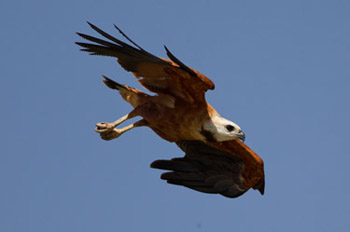





Top: Black-collared Hawk beginning to swoop down for a fish.
Middle: Black-collared hawk, Greater Black Hawk - both swooping and about to catch a fish.
Bottom: White-necked Heron, Great Egret.
It is an interesting point that the Black-collared Hawk is a fish eater that hunts and catches fish like many eagles, and like several fish-eating eages (Bald, Steller's, Sea, and others) this hawk has a white head. The question is, why do these fish-hunting birds all have similar coloration, having white heads? There must be some correlation but I don't know what it is, and so far, all the ornithologists I've asked had no answer. Do you?
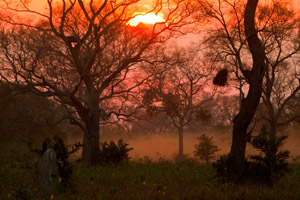 Day 3
Day 3
We were out in the field before sunrise, catching a fireball sunrise framed against Ype’ trees in a distant pasture. Dave and Phil were already in the Jabiru Stork tower, so Mary and I worked around the bird feeders at the lodge. The Toco Toucans came in for a short time, their glowing, huge yellow bills incongruous but somehow fitting their vivid black, white, and red-rumped plumage. They didn’t stay long, and by the time the stork people came back the birds had left.
Mary and I climbed the tower, and the activity up top was pretty tame until right before we left, when the most recent adult to fly into the nest regurgitated a slew of fish. These huge storks, distinctive with their swollen black necks, are surprisingly sedate at the nest. The four young storks quietly preened, and only occasionally tapped at the adult’s neck to solicit food. Eventually the adult obliged, and the young fed, quickly but without the sense of chaos or frenetic sense that many wading birds exhibit. While we watched, two Hyacinth Macaws flew by, later to be joined at a tree by two others which eventually flew on to another tree with an nesting box attached.





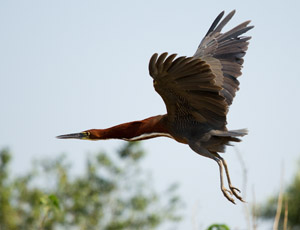


Some of the many wetland birds in the Pantanal, the largest wetland in the Americas. From upper left, clockwise:
Jabiru Stork, from the spiral staircase observation tower; the Rufescent Tiger Heron regurgitating and then reswallowing
a fish that apparently went down the wrong way; another tiger heron in flight; the great blue heron look-alike, the White-necked Heron
launching itself in flight and flying by with a fish (and this illustrates the importance and relevance of manual mode, spot-metering, as the black background would have fooled a programmed mode); and two immature Boat-billed Herons perched along some river side roots.
We left for Porto Joffre shortly after 8, enduring a long, dusty road with one stop, for the Great Horned Owl nest that is located in one of the larger roadside hammocks. The birds were more open than usual, and at one point, when one flew to a different perch, we had the clearest view, ever. Unfortunately it didn’t stay.
We arrived at PJ and headed up river to our houseboat, the Balsa, which is the largest and most appointed we’ve stayed in in the Pantanal. The rooms are fairly large, with a very spacious dining area and, we discovered, great food.
After lunch, at 3, we headed out for jaguars. My boat did a rather long survey of the river, checking last year’s Giant  Otter den, now empty, and passing on some birds, caimens, and capybaras that could have occupied our time. As we started our return home we started shooting, working first on a mother capybara and two cubs, and later on a pair of still-in-the-nest Rufescent Tiger Herons. While we filmed the capybaras a Rufous Hornero hopped up the shoreline, clambering aboard the mother rodent to pick for flies. We’d never seen that before, but later, as we cruised down river, I saw this happen again.
Otter den, now empty, and passing on some birds, caimens, and capybaras that could have occupied our time. As we started our return home we started shooting, working first on a mother capybara and two cubs, and later on a pair of still-in-the-nest Rufescent Tiger Herons. While we filmed the capybaras a Rufous Hornero hopped up the shoreline, clambering aboard the mother rodent to pick for flies. We’d never seen that before, but later, as we cruised down river, I saw this happen again.
The Tiger Herons sat unconcerned, then one unexpectedly regurgitated a fish which it maintained in its bill and reswallowed, apparently in a more comfortable position.
Mary’s boat found the Giant Otters and spent 45 minutes or longer with these, the largest of the Weasel family. Steve and Ann’s boat had them for over an hour, and loved it.


 Day 4.
Day 4.
AM. We left at 6:30, heading directly to a long slow-moving channel that we call the Black Lagoon. We hadn’t traveled far when we encountered five Giant Otters swimming up stream. Every few minutes one or several otters would surface with a new fish, then crunch it down noisily, head-first, dive, and return with another. For nearly 40 minutes we played chase with the otters as they swam about until the group led us back to their den. A small log lies braced between the water hyacinths and several otters clambered onto it to scratch or gobble fish. Nearby, a broken limb formed a chin rest for one of the otters that proceeded to rest its chin and nap for a few minutes before, almost inevitably, another otter swam up to play. We slowly moved closer and closer, finally getting too close for our minimum focus with our 500mm lenses and switching to shorter zooms. The otter had captured a fairly good size catfish and munched down the entire fish completely unconcerned by our presence. It was truly a special moment as we were far inside a possible fear-circle and the otter had accepted us fully.
We had tremendous luck in the Lagoon, with good kingfishers, a very cooperative, preening Anhinga that perched with its wings widely outstretched, framed against the shaded bank, and some of our most interesting shots with the Brazilian crocodilian, the Spectacled Caimen. It is breeding time, apparently, as several males lay suspended in the water, their heads and tails cocked high, appearing almost dragon-like. Eventually the male would raise its head still further and, in a 
sound that was felt almost as much as heard, the caimen would roar, vibrating the water in a cascade, hundreds of tiny fountains firing from its back. The call and display is probably more territorial than enticing, warning other males off rather than drawing in receptive females. We did come upon one confrontation where two adults faced one another, loudly sighing or hissing, their mouths’ partly agape. After several minutes they lunged, and in a massive splash disappeared beneath the black, tannin-colored waters.
We motored along all the normal jaguar routes without success, but upon our cruise back to camp we encountered four Howler Monkeys that cooperated nicely, with one female feeding on tiny leaves in full view. No one in our group saw a jaguar this morning, although another photographer had a brief encounter with one female very early on.
PM. We left at 3PM with towering thunderheads to our east and the intermittent shade of passing clouds made the first part of the afternoon tolerable. We headed back to the Black Lagoon, and although the family of Giant Otters were out and on their log, another photographer was there and, having had a great morning, we let him alone. We continued upstream, scouring the banks of a jaguar and passing up Anhingas and Kingfishers that we’d shot earlier in the day.
We continued on to the Three Brothers River where we did some fun shooting with a Capybara and Caimen that shared a large pile of detritus that resembled a giant beaver lodge. Both were lying peacefully alongside one another and we had a chance at shooting several angles.
 Further on, a family of Capybaras drew our attention but the young ambled off as we approached. Nearby, however, a Caimen laying basking on a submerged log and Dave thought it’d be a great reflection. We paddled in close, and the closer we got the better the reflection, as our advancing creating small waves that chopped up the scene. As we were about to leave I tried a different shot, holding my 28-300 at waterlevel and spray-firing left to right so that I’d have a chance of getting the crocodilian in the frame. For focus I used all 45 AF points in the ‘ring of fire’ and it worked, with 3-4 good shots out of the 40 or so I made.
Further on, a family of Capybaras drew our attention but the young ambled off as we approached. Nearby, however, a Caimen laying basking on a submerged log and Dave thought it’d be a great reflection. We paddled in close, and the closer we got the better the reflection, as our advancing creating small waves that chopped up the scene. As we were about to leave I tried a different shot, holding my 28-300 at waterlevel and spray-firing left to right so that I’d have a chance of getting the crocodilian in the frame. For focus I used all 45 AF points in the ‘ring of fire’ and it worked, with 3-4 good shots out of the 40 or so I made.


The Capybara family we filmed yesterday was again in a favorable position and we moved in close for more nursing shots in the golden light. A half hour from sunset we motored back up the San Pedro, finding a cooperative Black-collared Hawk perched within reach of our final forward progress, as water hyacinths now choke that river and prevent further travel upstream along one of our favorite locations. .jpg) While we shot a Rufus-tailed Jacamar, a metallic green, bee-eater-like bird, flew in to a neaby perch. We paddled in, eventually grounding our boat and finished the last light with flash on this very cooperative bird as it repeatedly dashed out to catch flying insects, sometimes right over my head!
While we shot a Rufus-tailed Jacamar, a metallic green, bee-eater-like bird, flew in to a neaby perch. We paddled in, eventually grounding our boat and finished the last light with flash on this very cooperative bird as it repeatedly dashed out to catch flying insects, sometimes right over my head!
As we raced back to our house boat in intensifying gloom we tried shooting the bats that often raced ahead or alongside our boat. I got one lucky half-decent shot before it became too dark to even see a bat, and our boatman navigated the nearly black water by the dim glow of a dulling western sky.
Mary's Second Portfolio







Top: Caimen with butterfly; the beautiful Pied Lapwing (Plover)
Second Row: Ringed Kingfisher. As large as this fish is, the kingfisher still swallowed it!
Third Row: Howler Monkey reclining; Brown Capuchin Monkey leaping from tree to tree, a bee or wasp's nest in its jaws.
Bottom Row: Female Bare-Faced Curassow
.
Day 5.
A sparkling, crystal clear morning with the sun rising as a red ball above the eastern horizon’s trees. We left at 6:30 and Mary’s boat, with John and Steve, and my boat, with Peter and Tom, headed up the Black Lagoon. The Giant Otters were not at their den but we soon encountered them further upriver where they were actively fishing. At one point four of the five otters captured fish and fed together on the edge of a raft of hyacinths, but it was impossible with our long lenses to get all four in one frame. On multiple occasions the otters would surface near us, rising high in the water and breathing loudly, reminding me of the Steller’s Sea Lions we’d seen in coastal Alaska just two weeks earlier. The otters constantly traveled, heading towards their den site but before we got there we received a radio call that a Jaguar had been seen upriver. We secured our gear and raced down river, heading to the Three Brothers.
As we raced upstream I watched the river banks, and sure enough I spotted another Jaguar lying next to a bush, its head and shoulders clearly visible. I yelled to our boatman, ‘Jaguar!’ and pointed, and for a moment he seemed confused, as we were heading to a jaguar somewhere on ahead. We stopped, found a convenient sand beach directly across the river, and beached there. The jaguar didn’t do much, either watching us or lying with its chin on its paws, but everyone had gathered by then and everyone in our group got shots. The ice was broken.
 We heard of another jaguar 10 minutes upriver, so my boat moved on and we found the jaguar just as it cleared the forest and walked in the mixed light along the forest edge of the beach. The shooting was brief, but the cat was full-frame and a female. She disappeared into the brush so we headed back to our first jaguar, but we should have stayed because the cat came out again, jumped into the water for a capybara, and walked in the clear for a few minutes before finally setting in deep shade a few yards from a steep river bank. We found her there but eventually she wandered deeper into the brush. We suspected she was hunting, but after a 45 minute wait, without a clue as to her location, we headed back to our houseboat to download CF cards and grab lunch.
We heard of another jaguar 10 minutes upriver, so my boat moved on and we found the jaguar just as it cleared the forest and walked in the mixed light along the forest edge of the beach. The shooting was brief, but the cat was full-frame and a female. She disappeared into the brush so we headed back to our first jaguar, but we should have stayed because the cat came out again, jumped into the water for a capybara, and walked in the clear for a few minutes before finally setting in deep shade a few yards from a steep river bank. We found her there but eventually she wandered deeper into the brush. We suspected she was hunting, but after a 45 minute wait, without a clue as to her location, we headed back to our houseboat to download CF cards and grab lunch.
PM. We left at 2:30, hoping to find one of the shoreline jaguars. Our boat checked out the Black Lagoon first, stopping at the Giant Otter den. All of the adults were present, moving in and out of two large burrows in the river bank. At one point I thought I saw an adult dragged out a baby otter but the vegetation obscured the view. Later, another pair of otters climbed up the bank, disappeared within the burrow, and, together, pulled out a pup. The manner was so rough it appeared as if they were fighting over a fish they intended on ripping apart. Once in the water they dunked it and played, and eventually grabbed it by the nape of the neck and disappeared back into the weeds.
We had a great Rufous-tailed Jacamar that one of our shooters wanted to shoot but try as we might we couldn’t point it out, despite the fact that it was less than ten feet from the front of my lens! It was a great opportunity lost, but hopefully he’ll have another chance with a bird with less vegetation nearby.
We left the otters when we got the call that the Jaguar was spotted again, only a few feet from where we’d last seen the female earlier in the day. We beached out boats on the sand bar and everyone climbed out, set up tripods and lenses, and waited. And waited. The cat never left the shelter of the forest and we gave up at sunset, beginning our rather short boat ride back while we still had some light to see. We didn’t get far when we found the male Jaguar we’d seen earlier in the day, now lying right next to the river bank. Everyone pulled up, grabbed flashes, and started shooting in a losing race with the light. Too soon it became too dark to even see the cat, and most of the shots were out of focus but a few photographers, including Chris and Peter, managed to get some sharp flashed shots. We returned back to the boat in absolute darkness, happy to be free of the mosquitos that descended upon us as we photographed the jaguar in the dark.


Day 6.
A 6:30 start with a beautiful sunrise and we headed to the Black Lagoon, our first stop as we searched for jaguars. We encountered the Giant Otters almost immediately, at their den where one adult carried a pup in its mouth, diving under the water and milling about. The otters were moaning, giving a call I hadn’t heard before, and I worried that the baby had  died and they were distracted. We watched as carefully as we could and eventually we spotted the baby alone, and moving, and our fears were unfounded. The otters never strayed far from the den area and one captured a large eel, climbing partially up onto a large log where the otter defended its catch from others trying to snatch pieces or the entire fish. Frustrated, these otters would groom, and I noticed for the first time their flat, vertically compressed tail, which I suppose acts like a rudder as they swim.
died and they were distracted. We watched as carefully as we could and eventually we spotted the baby alone, and moving, and our fears were unfounded. The otters never strayed far from the den area and one captured a large eel, climbing partially up onto a large log where the otter defended its catch from others trying to snatch pieces or the entire fish. Frustrated, these otters would groom, and I noticed for the first time their flat, vertically compressed tail, which I suppose acts like a rudder as they swim.
The otters’ fishing prowess is simply incredible, or the fish density is, for almost every dive results in a captured fish and, yesterday, we had four otters feeding together, all with their own fish. Two of our otters spent several minutes tapping and mulching the mud by the shoreline, a behavior we saw last year and couldn’t discern its meaning. I suspect it is a scent-marking, territorial display, as even hours later the site had the musky tang of mustelid, of otter. Eventually the otters disappeared, with some swimming upstream and others retreating into their den and we moved on.
I was with Ann and Steve and today was probably the most productive of many productive days here upriver. We had another very cooperative Anhinga, sunning itself and framed nicely against a nearly black background. Hoping to spot a jaguar we moved out of the Black Lagoon and headed upriver, but after an uneventful hour or so we returned to the Lagoon, figuring that our jaguars from yesterday could easily make the short, ½ mile trip from the river to the lagoon and we’d have as much a chance there as anywhere else. And, with the slow, nearly current-free water, the shooting would be easier.
Ann hoped to photograph a Capybara in vegetation, and the family group we found proved very cooperative. Normally we simply see these huge rodents basking or lounging on the bank but these were eating, cropping off the stems of hyacinths and the long blades of various grasses growing along the shoreline. We paddled close enough that I could try a water-level wide-angle,but the working distance proved a bit too far to be effective. A pair of Black-capped Donocobious foraged around the capybaras, occasionally perching upon one’s back as they watched for disturbed insects.

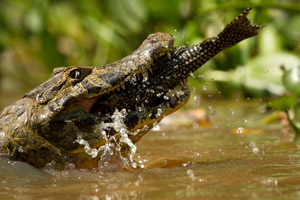
Later, I did use the wide-angle with a large Treefrog that our boatman found upon a hyacinth. These frogs are unbelievably cooperative, and as he held it on his hand it made no effort to hop off. Placed back upon the hyacinth we could rotate, pickup, or move the plant and the frog simply shifted position. Perhaps it instinctively knows it is safer on a plant during the day, no matter how disturbed, as the alternative, hopping into caimen-filled water, might be far more dangerous.
As we began our cruise back I spotted a Spectacled Caimen with a large catfish in its jaws. We swerved in a big, arching U-turn and came to a halt as the caimen tossed and crunched the fish, trying to manipulate it into a final position for swallowing. Best ever on this!
Mary, meanwhile, had spent nearly an hour earlier in the morning moored to a tree root where they could watch and  photograph a pair of Jabiru Storks returning to their nest. The adults took turns flying off, leaving for four or five minutes before returning with a crop full of water. When they landed the adult would bend over and purge the water in a long stream, going to each baby in turn to offer it much needed water. In the course of an twenty minutes the birds made three or four trips, with a bird leaving within a minute of the other adult returning with more water.
photograph a pair of Jabiru Storks returning to their nest. The adults took turns flying off, leaving for four or five minutes before returning with a crop full of water. When they landed the adult would bend over and purge the water in a long stream, going to each baby in turn to offer it much needed water. In the course of an twenty minutes the birds made three or four trips, with a bird leaving within a minute of the other adult returning with more water.
PM
We returned to the Black Lagoon but the otters were in siesta, or had swam far upstream to fish. We did well with some birds, including a Neotropical Cormorant that when I saw it I thought it looked tolerant. We eventually paddled so close that the bird filled the frame with my 200mm lens, at a distance of about 4 feet from my lens. Normally you can’t get within forty yards of a cormorant before it flies off, so the shooting was exceptional.
We left the lagoon and headed upriver, reaching the San Pedro by 5:20, a few minutes before sunset. Our guide really wanted us to spot a jaguar tonight, but although we motored back slowly until the light completely failed none appeared, nor were any seen today.
Mary's Third Portfolio
The Two Brothers



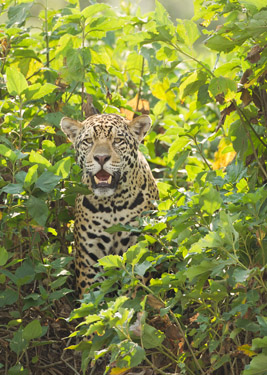

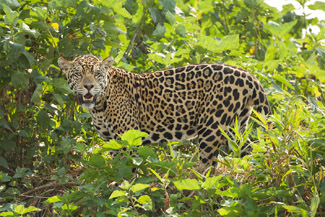



Mary had nearly 45 minutes of almost solo shooting, shared with Don and Margaret in her boat, as a pair of Jaguar brothers hunted along the Cuiaba River. At one point they almost captured a large green iguana right in front of their boat.In the top left image, one of the jaguars is looking up right after giving up on the hunt.
Day 7.
The skies were slightly overcast and we had a cool wind that, as the morning progressed, intensified and brought showers. We were expecting a cold front to move through but by afternoon it was reasonably hot again, so the weather hasn’t changed appreciably.
My boat headed to the Black Lagoon, hoping to start with the otters but again they had disappeared. Later that day we would discover why. We headed up the Three Brothers, slowly motoring as we watched for jaguars along the shore when we received a radio call that Mary’s boat had 2 Jaguars. We raced up the Cuiaba River, but it took nearly 35 minutes to reach Mary, who by then had been with the two male jaguars for nearly an hour. They had been actively hunting and she filled almost 3 16gb cards with shots of the two cats together, grooming, swimming, and walking. The two males were of different sizes, and we wonder if perhaps they were brothers from two different litters. In Africa, a mother leopard will sometimes tolerate cubs from a previous litter at a kill or in her area, and perhaps the same holds for jaguars and the two grew to be companions.
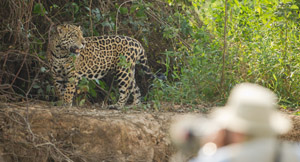 We followed the cats for more than 30 minutes, but the current was swift and the boat extremely rocky in the current. Worse, our boat had a light weight anchor in the front (for me to handle!) and the normal, very heavy anchor in the back. The foreward anchor wasn’t sufficient to hold the boat and by using two we ended up crosswise to the current, sometimes fouling other anchors. Some of the very best shots I saw but missed as the two came together or another boat, because of our wacky anchors, getting between us and the cats. Still, I blasted away, and hopefully got some sharp shots before the cats tired of hunting and retreated out of view. No worries here, though, as Mary got some truly spectacular shots!
We followed the cats for more than 30 minutes, but the current was swift and the boat extremely rocky in the current. Worse, our boat had a light weight anchor in the front (for me to handle!) and the normal, very heavy anchor in the back. The foreward anchor wasn’t sufficient to hold the boat and by using two we ended up crosswise to the current, sometimes fouling other anchors. Some of the very best shots I saw but missed as the two came together or another boat, because of our wacky anchors, getting between us and the cats. Still, I blasted away, and hopefully got some sharp shots before the cats tired of hunting and retreated out of view. No worries here, though, as Mary got some truly spectacular shots!
 We continued up the river until we came to one of the branches of the Three Brothers, which we followed, passing the old otter den area and eventually coming back to the main channel. Along the way we stopped at a beach where a large flock of Black Skimmers had apparently used for nesting. At one point the entire flock took off, circled us, and some skimmed the shoreline water with their lower bills. Skimmers 'skim' for fish in this fashion, dragging their lower bill to cut a swath as they fly with shallow wing beats above the surface. Should the bill touch a fish the bird snaps its head and its bill shut, grasping the fish as it flies by. We tried hand-holding our 500mm's for the shots, which was very difficult but did result in a few good shots. But it was tough.
We continued up the river until we came to one of the branches of the Three Brothers, which we followed, passing the old otter den area and eventually coming back to the main channel. Along the way we stopped at a beach where a large flock of Black Skimmers had apparently used for nesting. At one point the entire flock took off, circled us, and some skimmed the shoreline water with their lower bills. Skimmers 'skim' for fish in this fashion, dragging their lower bill to cut a swath as they fly with shallow wing beats above the surface. Should the bill touch a fish the bird snaps its head and its bill shut, grasping the fish as it flies by. We tried hand-holding our 500mm's for the shots, which was very difficult but did result in a few good shots. But it was tough.


PM.
We searched the Black Lagoon for otters but they were gone, but Mary found them about a mile upstream on the Three Brothers, where she filmed a mother carrying a pup into the den. The current here is strong, in marked contrast to the Black Lagoon, so the journey and transfer was rather extraordinary. I did some neat wide-angle shots of a Caimen, shooting at water level, and getting tail-end views where I had my camera almost at the end of the tail.
We continued upriver and received a call that the two Jaguars had been seen again, near the mouth of the San Pedro River. Amit, our friend and outfitter for India, was there, and finally got some photos of two jaguars (he had been skunked) and he saw, and shot, one of the jaguars as it charged into the water for a Caimen. It missed, and that was the last we saw of the cats. The jaguars had frightened some Capybaras, which swam along the shoreline, periodically giving their sharp alarm bark. I taped it, and later when these large rodents came back to shore I played the alarm bark back on my tape player. I expected some sense of alertness or alarm, but the capybaras seemed to completely ignore the call. I was surprised.
Day 8
Our last morning in the heart of Jaguar country and it was refreshingly cool. My boat, with Don and Margaret, headed up the Three Brothers into the general area where we’d seen the jaguars yesterday. Two of our other boats stopped at the new Giant Otter den, which in a direct GPS line was .5 miles from the old den, so an easy 1 mile or more by following the rivers. A long journey for the otters, but they were cooperative and despite the tow of the main river’s current everyone felt they had great shots as the otters fed upon fish.
We stopped for several birds, including a nice pair of Bare-faced Currasows that fed along a sand bank, a trio of very rare Swallow-tailed Kites perched above the river, and a Jabiru stork nest, and when we pulled into the slow moving waters of a tributary three Howler Monkeys in a fairly open tree, with the two juvenile males constantly wrestling.
My GPS battery ran out, which was a real disappointment as we covered stretched of the Three Brothers and the Campo Jaffre River which I’ve never been on. On one of these our boatman spotted a Jaguar, but it darted into the grasses before I even had a glimpse, and never returned to the bank.
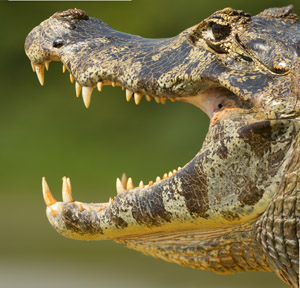

 Our best shots of the morning were of two large Spectacled Caimens that lay upon a high sandbank at the river mouth of one of these tributaries with the Cuiaba River. We moved in close and had frame-filling headshots, face-on, as one lay with its mouth wide-open. The caimens were higher on the bank than we were, so the angle was great.
Our best shots of the morning were of two large Spectacled Caimens that lay upon a high sandbank at the river mouth of one of these tributaries with the Cuiaba River. We moved in close and had frame-filling headshots, face-on, as one lay with its mouth wide-open. The caimens were higher on the bank than we were, so the angle was great.
We returned to the houseboat by 12:25 for a lunch before heading back on the river to Porto Joffre where we’d catch our transport back to our land-based lodge for two nights. The ride back was far less dusty than the trip down, and we saw some new birds, including a Savannah Hawk, and the chicks of a Southern Screamer, but everyone was anxious to return to the lodge.
That evening we did a Night Drive in the open truck, with Ricardo, Mary, and I manning the spot-lights. It started great, with the elusive Crab-eating Fox coming close right on our lodge’s grounds, and we had two Brazilian Tapirs, with one crossing the road in front of us and the other spotted as we returned to the lodge. There, too, our guide spotted a very rare Scissors-tailed Nightjar, a whip-poor-will-like goatsucker that sports two very long, streaming tail feathers. It stayed perched, close enough for some ok record shots.


The very rare Scissors-tailed Nightjar, shot with a 400mm f5.6 and a Tele-flash attachment. Soon afterwards, we had our second Brazilian Tapir close by. In both cases the flash, mounted on the hotshoe, created red-eye which I can later address in Photoshop.


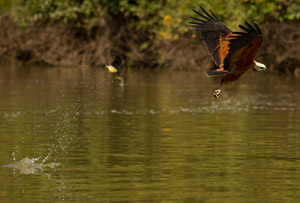

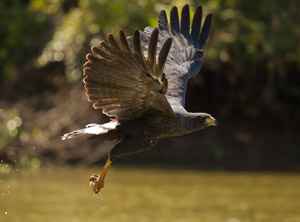
Above: A collage of the Black-collared Hawk swooping down for a fish, and, in the lower right, a Greater Black Hawk flying by after snatching a fish from the water.
Mary's Fourth Portfolio




On our last full day and at our land-based lodge we had one of the best jaguars we'd ever had, and, for our guide, only the third time he'd seen a jaguar here. Two of those three times occured today!
Day 9.
A cool start to the morning and surprisingly no one climbed the tower of the Jabiru Storks, which still have four now large chicks in the nest. The Toco Toucan came into the feeder but was shy, although Dave and Phil got some nice shots of the birds in flight. All of us gathered near one of the sugar feeders where the Orange-Backed Troupial, the brilliant oriole-like bird, flew in for frequent drinks. All of us tried our ‘bird baseball’ where we would fire as the bird launched from a branch, hoping to catch the bird in flight, and in focus. Harder than you might expect!
 At 9 we headed up stream to try our luck with flying Kingfishers, Black Hawks, and Black-collared Hawks, and we probably had our best luck yet. The Ringed Kingfishers were particularly cooperative, and most of us ended up getting a couple of shots – how really sharp remains to be seen.
At 9 we headed up stream to try our luck with flying Kingfishers, Black Hawks, and Black-collared Hawks, and we probably had our best luck yet. The Ringed Kingfishers were particularly cooperative, and most of us ended up getting a couple of shots – how really sharp remains to be seen.
We were setting up on another kingfisher when some Brazilian boatmen down river called to us, saying there was a jaguar on shore. We drifted down, and there she was, a nice female lying beneath a banyan-like tree. We were not completely prepared, without our big lenses and without our tripods, and with my non-IS 400mm f5.6 I was really struggling to get a sharp shot. She lay under the tree completely unfazed by us, and then a Capybaras swam downstream and climbed ashore on the opposite bank of a tiny channel that separated the rodent from the cat.

.jpg)

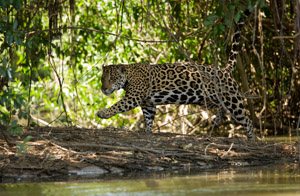
Our morning shoot, which started with fairly nice portraits of this female jaguar lying by some tree roots, became incredible when a capybara swam by, climbed ashore, and prompted a hunt. The jaguar leaped across the small channel twice, which surprised us since jaguars often wade or swim, as this cat would do later in the day.
 The Jaguar saw it, flattened, rose, and crept forward, then took a quick charge and leapt over the channel. Everyone fired, and all of us got some version of the jump, while the capybara, ignored by us, dashed somewhere to safety. The cat sat down momentarily, then jumped back over the channel and, after a few yards, disappeared into the forest. It was the best, and most exciting, jaguar sighting of the trip, and elated, we headed back for lunch, although a lonely kingfisher waited on a perch for another try at shots.
The Jaguar saw it, flattened, rose, and crept forward, then took a quick charge and leapt over the channel. Everyone fired, and all of us got some version of the jump, while the capybara, ignored by us, dashed somewhere to safety. The cat sat down momentarily, then jumped back over the channel and, after a few yards, disappeared into the forest. It was the best, and most exciting, jaguar sighting of the trip, and elated, we headed back for lunch, although a lonely kingfisher waited on a perch for another try at shots.
PM
After a great morning, the question asked was ‘How are you going to top that this afternoon?’ on the last boat ride of the trip. Turns out, we did, in spades.
We started with Ringed Kingfishers and Black-collared Hawks, and we were having modest success with both birds, with our boats working in coordination very well. Two hawks flew in and, to get the sun at our back, we moved upriver so that the birds would have to fly towards us, and into the sun. I’d just gotten myself into position and shouted down river for Ricardo, our new guide, to get his boat up to our boat when Peter, a few yards further upstream, quietly pointed to the shore and said ‘Jaguar!’
Our cat was back, resting on the same bank we had her on earlier in the day. She sat quietly, looking over her shoulder at us while we moved in to within frame-filling range of a 400mm, jockeying about in the mild current. Eventually our boats drifted to the opposite shore where we parked ourselves to wait, hoping that the jaguar would get up and drink, or leap across the stream again. Almost 1.5 hours went by and the cat barely moved, although with her resting spot now in shade we decided to move in and get some shots while we still had some light.
 As we advanced, quietly, slowly, the cat began to groom, raising a hind leg and licking the base of her tail. She was oblivious. After several minutes she got up and moved off into the forest, and I thought we were finished. Luckily, another boat upriver, who had politely held back to view the jaguars, signaled us that the cat was ahead. She had entered the river and was hunting.
As we advanced, quietly, slowly, the cat began to groom, raising a hind leg and licking the base of her tail. She was oblivious. After several minutes she got up and moved off into the forest, and I thought we were finished. Luckily, another boat upriver, who had politely held back to view the jaguars, signaled us that the cat was ahead. She had entered the river and was hunting.
For the next thirty minutes or so we followed the jaguar as she waded into the river, swam, walked along the bank, and charged at caimens she flushed from the shoreline. Ricardo pointed out that she was afraid, seemingly, of a caimen facing her, as she stirred the water with her paw. I never saw the caimen until I looked at my computer, as I was so intent on trying to keep my water horizon level. Eventually the jaguar headed into the river to swim across, but turned back and moved a little further upstream. We held back, and this time she crossed, and in the final light of the day we followed her for a few minutes as she began hunting the sandy bank of the opposite shoreline. In all, it was about a 20 gb afternoon on jaguars – not quite Mary’s 30 some gb of three days ago, but good enough.


Our replacement guide is a great naturalist, and he told us of several hunts he’d seen in 12 years of guiding. He’s only seen one successful hunt that resulted in a capybara kill, but he’s seen jaguars hauling out large caimens, and an unsuccessful Giant Otter hunt where the otter escaped. Afterwards, the entire family of otters bobbed in the water, chattering at the jaguar that lay upon the shoreline licking its paws, as if challenging the cat to try again. Doing so, could be a fatal mistake for the jaguar. He’s seen jaguars swimming across the rivers where a family of Giant Otters would harass the cat, swimming behind and diving, biting the jaguar’s legs. I suspect that a group could drown a cat if they had the chance.
The guide had a new respect for Capybaras, he said, when he watched a jaguar hunting, approaching a couple of capybaras from the water, rather than stalking from the land. One capybara apparently saw or sensed the jaguar and darted into the water, but the other stayed put. The other stood its ground, and whether or not that was cluelessness or not (I suspect the former, myself) it stayed until the jaguar charged, and somehow it escaped the grasp of the jaguar, dashed into the water, and disappeared.

We’ve seen many Capybaras as they darted or dove into the water, diving head-long from gentle slopes or steep banks, then swimming quite a distance before surfacing. When disturbed by a jaguar the rodents would give a sharp, bark-like alarm call. I used my shotgun microphone and taped a capybara doing just that, and later, when several came ashore, I replayed the alarm call. The capybaras showed no interest, completely ignoring the call.
On our last evening we did our usual Trip Highlights, Favorite Place and Favorite Shots. For most, the jumping Jaguar from this morning was one of the favorites, but other choices were more diverse – from a flying Orange-backed Troupial, a Caimen gulping down a sucker-catfish, a wide-angle water level shot of a caimen, Giant Otters eating fish, and more. The quiet waters of the Black Lagoon was several people’s favorite place, as it was mine, as I love shooting in still, virtually currentless waters. We celebrated the unofficial 60th wedding anniversary of Don and Margaret, marking the conclusion of the evening and the end of a great tour.
Day 10.
As I write this I’m sitting in the Sao Paulo airport, in a crowded cafeteria where the group waits for flights. We departed at 6 for our return to Cuiaba, dropping Don and Kris off at a small airport in Ponce’ for a chartered flight to the southern Pantanal. Our Cuiaba-SP flight went uneventfully, except for a small hassle for Steve when the ticket agent said his carry-on camera case was too large. We talked our way through it, and Steve had no problem boarding the Air Bus, which had plenty of room for all of our camera equipment.
With that, this journal ends.

 We will be doing this trip again in August and early September of 2012. On trip 1 we will be doing an extension to northern Brazil for 'Einstein' brown capuchin monkeys, maned wolves, flocks of hyacinth macaws, and many species of tropical birds at the bird feeders. On Trip 2 we plan on doing a scouting trip to the southern part of the Pantanal, where we'll be searching for Giant Anteaters, Ocelots, Armadillos, and various birds. The main trips are limited to 10 participants, with Mary and me leading the trips. Contact our office if you are interested -- spaces are obviously very limited, but there may be a few openings still available.
We will be doing this trip again in August and early September of 2012. On trip 1 we will be doing an extension to northern Brazil for 'Einstein' brown capuchin monkeys, maned wolves, flocks of hyacinth macaws, and many species of tropical birds at the bird feeders. On Trip 2 we plan on doing a scouting trip to the southern part of the Pantanal, where we'll be searching for Giant Anteaters, Ocelots, Armadillos, and various birds. The main trips are limited to 10 participants, with Mary and me leading the trips. Contact our office if you are interested -- spaces are obviously very limited, but there may be a few openings still available.
Read more about the Pantanal, and our scouting trip to northern Brazil for the monkeys and wolves, in our 2010 Trip Report.
If you'd like to see our other years' various Trip Reports, and photos that help to illustrate the story, check out the Home Page and the reports listed there or all of our trips for the last few years at the Report page.


